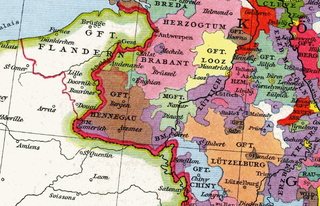
The County of Mark was a county and state of the Holy Roman Empire in the Lower Rhenish–Westphalian Circle. It lay on both sides of the Ruhr river along the Volme and Lenne rivers.

The County of Loon was a county in the ancien regime Holy Roman Empire, which corresponded approximately with the modern boundaries of the Belgian province of Limburg. It was named after the original seat of its count, Loon, which is today called Borgloon, but during the middle ages the counts moved their court to a more central position in Kuringen, which is today a part of Hasselt, the modern capital of the area.

The Duchy of Cleves was a State of the Holy Roman Empire which emerged from the mediaeval Hettergau (de). It was situated in the northern Rhineland on both sides of the Lower Rhine, around its capital Cleves and the towns of Wesel, Kalkar, Xanten, Emmerich, Rees and Duisburg bordering the lands of the Prince-Bishopric of Münster in the east and the Duchy of Brabant in the west. Its history is closely related to that of its southern neighbours: the Duchies of Jülich and Berg, as well as Guelders and the Westphalian county of Mark. The Duchy was archaically known as Cleveland in English.

La Marck, original German name von der Mar(c)k, was a noble family, which from about 1200 appeared as the Counts of Mark.
Adolph III of the Marck was the Bishop of Münster from 1357 until 1363, the Archbishop of Cologne in 1363, the Count of Cleves from 1368 until 1394, and the Count of Mark from 1391 until 1393.

Arnold IV of Loon (Looz), was Count of Loon from 1227 to 1273 and Count of Chiny from 1228 to 1268. He was the son of Gérard III, Count of Rieneck and Cunegonde von Zimmern.
Adolph II of the Marck was Count of the Marck.
Eberhard I was a German nobleman. He was Count of the Mark from 1277 until his death. He was the son of Engelbert I, Count of the Mark en Cunigonde of Blieskastel.
Margaret of Cleves, also spelled Margaretha or Margarethe was the wife of Count Adolf II of the Marck and mother of Adolf III of the Marck. She was a daughter of Count Dietrich VIII of Cleves and Margaret of Guelders, who was a daughter of Reginald I of Guelders.
Louis IV the Young, Count of Chiny from 1189 to 1226, son of Louis III, Count of Chiny, and Sophie. Louis was the last of the first dynasty of Counts of Chiny. Having no son, he prepared his eldest daughter Jeanne as his successor. Louis marked his reign by issuing the first postage stamp in the county.
Joan was the Countess of Chiny. Joan was the daughter of Louis IV, Count of Chiny, and Matilda of Avesnes, and became ruler of the county upon her father’s death on 7 October 1226. She married Arnold IV, Count of Loon, son of Gerard III, Count of Rieneck, and Kunigunde von Zimmern, in 1228, whereupon he assumed the role of Count of Chiny.
John I (Jean), Count of Looz and Count of Chiny, eldest son of Arnold IV, Count of Looz and Chiny, and Jeanne, Countess of Chiny. He succeeded his father in 1272 or 1273, as the Count of Looz and Chiny. Virtually nothing is known about his reign.
Godfrey de Heinsberg, Lord of Daelenbroeck, Count of Looz and Count of Chiny (1361-1362), son of John of Heinsberg, Lord of Daelenbroeck, son of Arnold V, Count of Looz and Chiny, and Catherine de Vroon.
Arnold VI de Rumigny, Count of Looz and Count of Chiny (1362–1364), son of William of Oreye, Lord of Rumigny, and Jeanne de Looz, daughter of Arnold V, Count of Loon and Chiny, and, Marguerite Vianden, Lady of Perwez and Grimbergen.
Gérard , Count of Loon (1171–1191), was son and successor of Louis I, Count of Looz, and Agnes of Metz. Because of a widespread misunderstanding concerning a document from 1101, some generations earlier, he is often wrongly referred to as the second Gerard in this dynasty.
John II ,, Lord of Jülich, Heinsberg and Löwenberg, son of Godfrey de Heinsberg, Count of Looz, and Philippa of Jülich, daughter of William V, Duke of Jülich, and Joanna of Hainaut. Although John was the first son of Godfrey, he did not inherit the countship of Looz, the title instead going to Arnold of Rumingy.
Adolph II von der Mark was the Prince-Bishop of Liège from 1313 until his death in 1344.